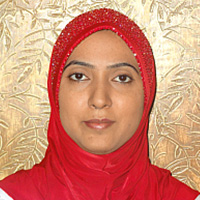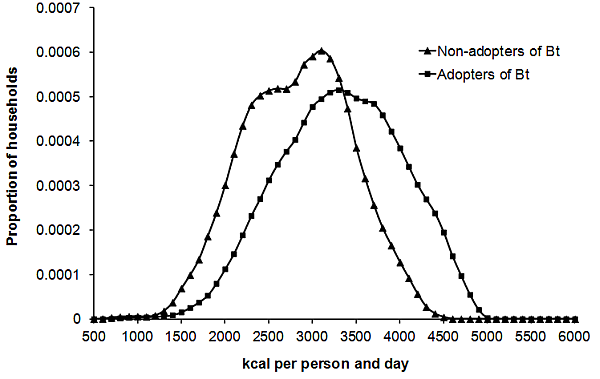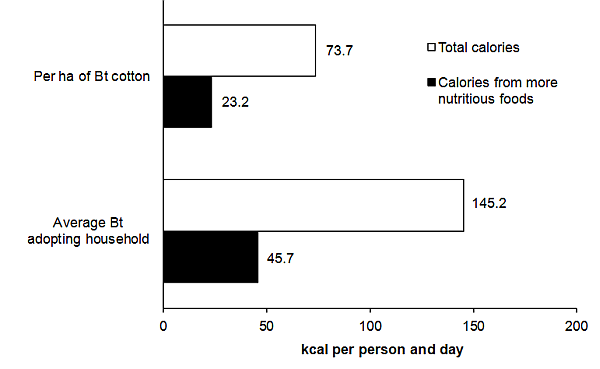The role of genetically modified crops in the fight against hunger remains disputed. The debate primarily focuses on whether or not these crops can contribute to sustainable increases in food production. However, food security is not only a question of production, but also of economic and social access to food. This column summarises research showing that the adoption of genetically modified cotton has improved food security among Indian smallholder farmers.
Hunger and undernutrition are still widespread problems in many countries, including India. In this connection, the role of genetically modified (GM) crops is often debated. Some see the development and use of GM crops as key to reducing hunger, while others consider this technology as a further risk to food security. Solid evidence to support either of these views is thin.
How can GM crops affect food security?
GM crops could affect food security through three possible pathways. First, GM crops could contribute to an increase in food production and thus improve the availability of food at global and local levels. Second, GM crops could affect food safety and food quality. Third, GM crops could influence the economic and social situation of farmers, thus improving or worsening their access to food. The third aspect is of particular importance because a large proportion of all undernourished people worldwide are smallholder farmers.
With regard to the first pathway, GM technologies could increase the yield of food crops and make them more robust to adverse climatic conditions and diseases. This could stabilise and increase food supplies, which is important given increasing food demand, climate change, and land and water scarcity. In 2012, 170 million hectares – around 12% of the global arable land – were planted with GM crops, such as soybean, corn, cotton, and canola, but most of these were not grown primarily for direct food use. Lack of public acceptance is one of the main reasons why GM food crops have not yet been commercialised widely.
Looking at the second pathway, crops with new traits can be associated with food safety risks, which have to be assessed and managed case by case. But such risks are not specific to GM crops. Long-term research confirms that GM technology is not in itself more risky than conventional plant breeding technologies. Moreover, GM technology can help to breed food crops with higher contents of micronutrients; a case in point is Golden Rice with pro-vitamin A in the grain. Such GM crops have not yet been commercialised. Projections show that they could reduce nutritional deficiencies among the poor, entailing sizeable positive health effects.
The third pathway relates to GM crop use by smallholder farmers in developing countries. Around half of the global GM crop area is located in developing countries, but much of this refers to large farms in South America. One notable exception is Bacillus thuringiensis (Bt) cotton, which is grown by 15 million smallholders in India, China, Pakistan, and a few other developing countries. Bt cotton is resistant to important insect pests, especially cotton bollworms. Several studies have shown that Bt cotton adoption reduces chemical pesticide use and increases yields in farmers’ fields. There are also studies that have shown that these benefits are associated with increases in farm household income and living standard. However, there is no research that has analysed what Bt cotton adoption means for food security. While higher incomes are generally expected to cause increases in food consumption in poor farm households, cotton is a non-food cash crop and hence, the impact on nutrition is uncertain.
Bt cotton: The Indian experience
Bt cotton was first commercialised in India in 2002. By 2012, over 7 million farmers had adopted this technology on 10.8 million hectares – equivalent to 93% of the country’s total cotton area. To analyse the effects of Bt cotton on food security, we repeatedly surveyed more than 500 randomly selected farm households during 2002-2008 in the states of Maharashtra, Karnataka, Andhra Pradesh and Tamil Nadu1 (Qaim and Kouser 2013). This is the first study that analyses the actual effects of Bt cotton or any other GM crops on food security with household data.
The data show that Bt adopting households consume significantly more calories than non-adopting households, and a smaller proportion of them is food insecure. Being food insecure is defined as consumption below the safe minimum daily intake of 2,300 kilocalories (kcal) per person (Figure 1).
Figure 1. Distribution of calorie consumption for adopters and non-adopters of Bt cotton
However, simply comparing the calorie consumption between Bt adopting and non-adopting households may be misleading. For instance, Bt adopting households may have larger farms, more favourable agro-ecological conditions, better education, or other characteristics that contribute to higher incomes and consumption. Hence, observed differences in calorie consumption may not be due to Bt adoption alone. If this is the case, a simple comparison would overestimate the net impact of the technology. We used statistical techniques to control for possible confounding factors and to estimate unbiased net impacts of Bt cotton adoption on calorie consumption.
Reduction in food insecurity
Controlling for other factors that might affect calorie consumption; we find that each hectare of Bt cotton has increased total calorie consumption by 74 kcal per person per day. For the average adopting household with close to 2 hectares of Bt cotton, the net impact is 145 kcal per person, implying a significant increase over the average calorie consumption in non-adopting households (Figure 2). Most of the calories consumed in rural India come from cereals that are rich in carbohydrates but less nutritious in terms of protein and micronutrients. Yet the results show that Bt adoption has also significantly increased the consumption of calories from more nutritious foods such as pulses, fruits, vegetables, and animal products (Figure 2). This is a clear indication of improved dietary quality. The analysis further suggests that Bt cotton adoption has reduced food insecurity in India by 15-20% among cotton-growing farm households.
Figure 2. Net impact of Bt cotton adoption on calorie consumption
Concluding thoughts
Our study confirms that income gains through Bt cotton adoption among smallholder farm households in India have positive impacts on food security and dietary quality. The cash income gains are used by households to purchase more and better food. While GM crops are not a panacea for the problems of hunger and malnutrition, our findings suggest that they can be an important component in a broader food security strategy. So far, food security impacts are confined to only a few concrete examples, such as Bt cotton. The nutritional benefits could further increase with more GM crops and traits becoming available in the future, including food crops. Appropriate policy and regulatory frameworks are required to ensure that the needs of poor farmers and consumers are taken into account and that undesirable social consequences are avoided.
The study on which this column is based can be accessed at http://dx.plos.org/10.1371/journal.pone.0064879.
Notes:
- Using a structured questionnaire, households were interviewed about input-output details in cotton production, other economic activities, and their broader demographic and socioeconomic conditions. Sample households grow around 2 hectares of cotton on average and most of them are relatively poor with annual per capita incomes ranging between $300 and $500. The questionnaire also included a detailed food recall, where household members reported about the quantity of all food items consumed over a 30-day period. This information was used to calculate calorie consumption levels per person. The demographic structure in terms of the age and gender of household members was taken into account.
Further reading
- Kathage, J, Qaim, M (2012), ‘Economic impacts and impact dynamics of Bt (Bacillus thuringiensis) cotton in India’, Proceedings of the National Academy of Sciences USA, 109: 11652-11656.
- Krishna, V V, Qaim, M (2012), ‘Bt cotton and sustainability of pesticide reductions in India’, Agricultural Systems, 107: 47-55.
- Qaim, M (2009), “The economics of genetically modified crops”, Annual Review of Resource Economics, 1: 665-693.
- Qaim, M, Kouser, S (2013), ‘Genetically modified crops and food security’, PLOS ONE 8(6), e64879, http://dx.plos.org/10.1371/journal.pone.0064879.
- Subramanian, A, Qaim, M (2010), “The impact of Bt cotton on poor households in rural India”, Journal of Development Studies, 46: 295-311.




 24 June, 2013
24 June, 2013 







Comments will be held for moderation. Your contact information will not be made public.